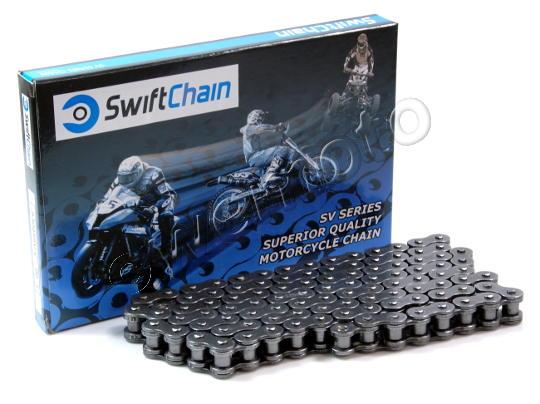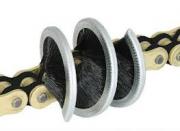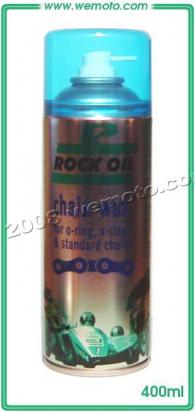In the middle of a chain - lube - reaction
The value of the not so humble motorcycle chain and how to keep it happy
Some people may think that the chain is rather an unglamourous part of a motorcycle, as it quietly gets on with its chainy business down near the ever- rolling road. However those same people would do well to think more about their chain and give it the attention it deserves as it is fulfilling a vital function, transferring the energy from that hardworking motor to the rear wheel and actually making the motorcycle go along. Put like that, you start to see the value of the maybe NOT so humble chain.
It is worth thinking about what would happen if the chain were to fail while you were moving along then disaster could strike! The chain, if it did break, would be unlikely to come loose and fall harmlessly away like a discarded snake's skin – no, a flailing chain can do some damage and take other things out with it – not thorough any malicious motive you understand, chains generally have a pleasant temperament and are equable and well balanced, but if they do go all Mr Hyde, then they can fling their way into catastrophe. It has been known for them to catch in the rear wheel and cause a skid, or rip through the soft aluminium of the engine and damage it.
At the very least the chain breaking will cause the motorcycle to stop as without it, there is nothing to connect the engine and the rear wheel so no forward movement will be possible once the chain has snapped.
So all in all, the chain in all its black sliminess is a very very important and hardworking part of any motorcycle and deserves to be treated with respect and kept well oiled (in a slippery way not a drunk way that is).
Why it is important to keep your chain lubricated
The idea of chain lube is to keep the metal surfaces of chain and sprockets apart and moving smoothly over each other without grinding against each other in a rusty or gritty way. If a chain is not sufficiently lubricated, the metal surfaces between the chain and the sprockets will grate against each other which puts greater stress on the chain and can stretch it and eventually lead to it snapping.
There are two types of motorcycle chain those with and those without O rings.
O ring chains
O ring chains have small rubber rings inside the links of the chain whose function is to keep the lubricant in, so that the chain does not dry out and become gritty and graty. O ring chains are usually used on bigger bikes as they can cause a bit more drag for the engine as it turns the chain as they are stiffer – negligible for a big bike but not so insignificant for a small one. The advantage of O ring chains is that the lube is sealed inside the links by the rubber O ring so lubing them is only

Swift O ring chain
really to keep the outside of the O ring protected to prevent grit and crud getting in, as in theory the O ring is sealing in the lubricant in the centre of the link already. You should make sure that you keep your O ring chain well lubed, ideally every 500 miles of riding.
Non O ring chains
Chains without O rings are usually found on smaller bikes. The chain itself is generally smaller so the lube can penetrate more easily into it. Non O ring chains are usually chosen for smaller bikes as they cause less drag and take less energy out of the engine to turn which is important on a lower cc motorcycle. Although lube can penetrate Non O ring chains more easily – as you might imagine it can also leave the chain more rapidly too, as there is not so much to hold it in place, so with a Non O ring chain you will need to lubricate it much more frequently.
When to lubricate your chain

Tirox 360 degree chain cleaning brush
Your chain should be lubricated when it is warm just after riding as this enables the lube to dissolve and be drawn into the chain as it cools forming a slippery layer between the chain and the sprockets so that they don't grind against each other.
The first step is to put the bike on its centre stand and clean the chain thoroughly using a special
chain cleaning brush if you have one and one of the proprietary cleaners like muc-off or rock oil chain cleaner
Cleaning products
It's best to work on small sections of chain at a time to make sure that you are cleaning it all thoroughly. Turn the rear wheel slowly cleaning each bit at a time. Then go back over it lubricating it. Use a mark on the swingarm as a guide so that you can tell where you have got to and don't end up doing a Forth Bridge impression.
Pizza the action
Always leave your bike for at least 15 minutes after cleaning and lubricating the chain before you

Have a break from lubing, eat this, then use the box!
ride it and be careful when you apply chain lube to make sure that you are not getting any of the lube on any brake parts as 'slippery' and brakes do not go together.
Equally don't get any lube on the tyres – an old Pizza box,
newspaper or bit of cardboard between the tyre and the chain will protect it when you apply the lube to the chain - you know it makes sense.
Different types of Chain Lube
Now there are many different types of lube available for your chain it's really a matter of which you prefer– thick and sticky or thin and watery – here are a few types:
basic wax
foaming wax
conventional lube
foaming conventional lube
Different lubricants will provide different levels of fling, cling and creep
You what??
Creep: the amount the lube penetrates all the parts of the chain
Cling: the amount the grease clings to the chain and resists flying off as the chain turns
Fling: how much grease flies off the chain as it revolves
Creep - well that is an all round good egg – the more of a creeping capillary action the chain lube has, the more it will wend its way into all the nooks and crannies of your chain coating it all through and through and therefore protecting all the contact surfaces
Cling - is good and bad - it is how much the lubricant holds on tightly to the chain as it spins and resists being flung off – but the darker side of cling is that it is generally thicker lube which has the ability to hold on this tightly and that can mean that grit and grime from the road also stick to it coating the chain and forming a grating surface as the chain revolves. So its tenacity is good but it needs watching and cleaning off and replacing when it acquires a designer stubble of grit.
Fling - not so good...or is it..? This is one of the eternal questions of the human condition and concerns the amount of lubricant which is flung off when the chain spins – some may say that this is good as it means that grot from the road is flung to oblivion (ie the inside of the rear mudguard) with the flying lube as it leaves the chain, and some may say that it is bad as the chain will need re-lubing sooner if the lube is flying off to pastures new. Who knows, just keep up the lubing if the chain looks either lube light or grot encrusted.
Mission Possible
Now your mission, should you choose to accept it, is to try out various
different forms of lube until you alight upon a favourite, here are a few alternatives for you to try out:
Rock oil chain wax
Offers the latest development in synthetic lubrication, engineered to give the ultimate protection for high performance motorcycle chains (o-ring and non o-ring types). Thin at application, to penetrate all surfaces. After a suitable drying time chain wax dries out to a highly slippy wax like film. Highly resists fling and water wash out once set.
Chain wax protects against wear, stretch, absorbs shockloading and reduces friction. Not being a tacky type, chain wax does not attract airborne particles.
Motorex chain lubricant Road
White chain lubricant. Specially formulated for road-going motorcycles. Tested for O-rings, X-rings and Z-rings. Extremely good adhesion, resistant to water. Extends the working life of the chain kit.
Motorex Off road also available
Dry Chain Lube
Wurth Dry Chain Lube comes in a 150 ml Aerosol and is a high specification wax lubricant. Its unique ability to penetrate the tightest gaps and links means that the hard wearing lubricant coats all the surfaces of the chain. Due to the low 'build-up' technology dirt and grit will not stick to the chain thus extending the chain's life. Wurth recommend two even applications.
So perhaps you are feeling inspired now and are going to go to that pizza shop and then get lubing - any thoughts on lube likes and dislikes we would like to hear them...
Wemoto




